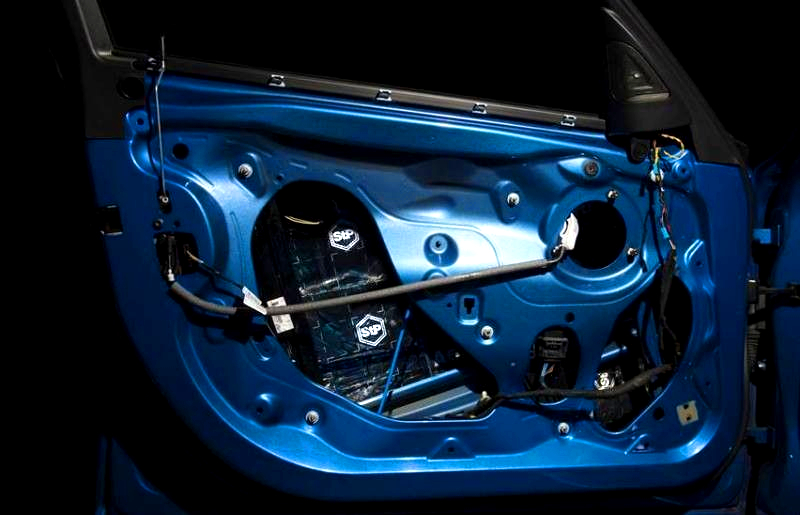The doors of a vehicle operate as resonance boxes for the loudspeakers. Without a well-functioning resonance box a loudspeaker cannot reproduce sound in the way it should. This applies both to loudspeakers that are part of your HiFi set at home as well as to the loudspeakers in your car. On this tips page we explain how to transform your doors into acoustically well-functioning loudspeaker boxes, in order for you to be able to enjoy your music more whilst driving.
Standard door
A door without acoustic adjustments is actually nothing more than a tin drum that vibrates along with the resonance from the loudspeakers. This causes a lot of energy produced by the loudspeakers to get lost. In an acoustically qualitative door, this energy is translated into a dynamic reproduction of the music and makes it a lot sound better. Apart from that, an untreated door often sounds like a gong when closing and allows noise from driving and the wind to be audible inside the vehicle.
Standard car door acoustics
Regular acoustic adjustments can be found in vehicles with loudspeakers that were installed at the factory. With car doors that underwent standard acoustic adjustments music will already sound more dynamic and full. Driving noise and noise produced by the wind will also be less audible. In case your car doors are untreated and you want to achieve this level of acoustic adjustments you can use the following products:
Extreme car door acoustics More radical car door adjustments are mainly meant for the heavier type of loudspeakers that are driven by (extra) amplifiers. The selected products will ensure an optimal reproduction of (extremely) low frequencies. The output in terms of volume in decibel inside the vehicle will also be higher after applying these heavier types of anti-drumming mats. As for extreme acoustic adjustments, you should make use of the following products.
More radical car door adjustments are mainly meant for the heavier type of loudspeakers that are driven by (extra) amplifiers. The selected products will ensure an optimal reproduction of (extremely) low frequencies. The output in terms of volume in decibel inside the vehicle will also be higher after applying these heavier types of anti-drumming mats. As for extreme acoustic adjustments, you should make use of the following products.
- STP Aero Bomb
- Vibraflex Extreme
Step-by-step plan for the application of anti-drumming mats
This step-by-step plan can be used for every type of car door and product type, there is no difference in how you should apply the products.
-
Step 1: Stripping
First of all, you need to strip the whole car door, in order to ensure access to the entire inside. Both the inside of the external sheet as well as the frame to which the covering panel was attached have to be accessible. -
Step 2: Cleaning
It is very important that the entire door is clean, in order to ensure a good adhesion of the products (which are all self-adhesive). For this purpose, you can use break cleaner or a detergent that doesn't contain fat or oil. Make sure not to leave any residue, which could potentially affect the self-adhesive layer of the product you are using. -
Step 3: Cutting the products to size
Anti-drumming mats can be cut to size with a hobby knife, the STP products can even be cut by means of scissors. Make a template from carton or paper for the more complex shapes. Most of the products are ideally cut at low temperatures, which ensures your knife or scissors stays clean (you should apply the mats after warming them up!) -
Step 4: Applying the anti-drumming products
The anti-drumming mats should be applied to the inside of the external plate and the frame to which the cladding panel is mounted. The wholes of this frame can also be masked, as such, the door is completely closed. Warm up the mats till well above room temperature in order for them to be flexible and adjust to the shape of the substrate.
Preheating works best with a hair dryer or a painter's blowtorch. Heat up the product to a level that still allows you to touch it. Prevent air bubbles underneath the mat while applying the product and try to cover as much door space as possible. Our pressure roller is a handy tool for this job. And, it goes without saying, you should leave the round loudspeaker's hole open. -
Step 5: Optional, applying absorption material
There are situations in which a somewhat hollow reverberation can be perceived, caused by sound reflections inside the car door. Like in the case of HiFi loudspeakers, the car door can be filled with some 'speaker filler'. If there is enough space between the window and the external plate, you can apply Akotherm by making use of a spray bottle of contact adhesive. Apply this material to the anti-drumming panels. Akotherm Basic D40 with a thickness of 20 mm is suitable for this purpose. The only condition is that there is enough space to reach the external plate.
Should I choose STP Standartplast or Vibraflex?
This choice mostly depends on how easy you want the application to be. STP products are made from butyl rubber and have two main advantages. Even at lower temperatures these materials are already quite flexible and very flexible after shortly heathing them up. On top of that, these products can be easily cut to size and they are easy to apply. Vibraflex is a material based on bitumen and because of that it is a bit cheaper, but it takes longer to heat it up.
Questions? 
Do you have any questions concerning this topic? Please feel free to contact us, we will be happy to answer your questions as soon as possible.

 Sound Absorption
Sound Absorption  Sound Insulation
Sound Insulation  Vibration Isolation
Vibration Isolation  Silent Ventilation
Silent Ventilation  Accessories
Accessories  Thermal & Acoustic Insulation
Thermal & Acoustic Insulation